Harvesting Terroir: Wild Honey from the Gurung Hills
A firsthand look at Nepal’s Himalayan honey tradition.
📸 Photo Credit: All honey hunt photos in this post were taken by my talented friend and fellow Peace Corps Volunteer, Townsend Dotterer. So grateful to her for capturing this event so beautifully.
We are approaching four months in country, and I am continuously learning about all the wonders and experiences that Nepal has to offer. One of these wonderful gems of an experience was observing a wild honey hunt—a longstanding practice of the Gurung ethnic group to harvest honey from cliff sides. Specifically, the honey from the biggest bee in the world, the Himalayan honey bee, Apis laboriosa. If you Google “Nepal Honey Hunt,” you can find dramatized videos where they harvest and try the "mad honey." I must admit that this was my initial introduction to the traditional practice, something that came across my YouTube feed many years ago, but it was something I revisited during our beekeeping trainings in Peace Corps' Pre-Service Training. The honey harvested here has been nicknamed "mad honey" for its hallucinogenic properties, caused by the pollen collected from the Rhododendron flower—Nepal's national flower. I should clarify that there is a lot of variety in the honey that is harvested, and the honey that my peers and I tried during this specific hunt was not, in fact, "mad."
A fellow volunteer living in a village just a few kilometers up the road from me was kind enough to organize this event for any Peace Corps Volunteers who were interested. This village is known for being more of a touristy village, just within the designated Annapurna Conservation Area, with incredible scenic views of the Himalayas. She had specifically been assigned to this village for one year to serve with a focus on eco-tourism. Observing honey hunts is one of the tourist activities she is working to help promote, and it was really special that she was able to organize one for Peace Corps Volunteers. When I was told about this event, I knew immediately that it was something I needed to attend!
This village is so incredibly picturesque. On a previous visit, I had the best dal bhat of my life and took one of my favorite photos of the mountains so far (attached here). Our honey hunt adventure began the evening before, on the very hill pictured in that photo, where we had a debriefing about what the following day would entail, along with some more context for a Gurung honey hunt. I learned lots of interesting facts, such as that the Himalayan honey bee can grow to be over an inch long, is only found in the Himalayan region, and nests only at altitudes over 2,500 feet. After the briefing and our questions were answered, safety gear—including a bee veil and gloves—was distributed. We left that evening filled with anticipation for the day ahead.
Although this is a post about the honey hunt itself, I want to mention my dear friends Townsend, Emma, and Elle, who also attended the event. There is only one hotel in this village, but we had instead opted to stay at a homestay. We were served a delicious home-cooked dal bhat for dinner with some raksi to close off the evening. The four of us shared a room, with Emma volunteering to sleep on the floor, and it brought back all the magic of slumber parties—something I hadn’t experienced in a while. It's also worth noting that Townsend had never seen Avatar: The Last Airbender, so in addition to our giggling and gossiping, we concluded the evening curled up with tea and introduced the masterpiece that is Avatar to Townsend on the small screen of my laptop. A magical evening that acted as a perfect prelude to what would be a magical next day.
We started the next morning at 7:30, all of us meeting at the one bus stop in the village. In total, there were about 20 Peace Corps Volunteers, four other international tourists, and about five Nepali tourists. As for the honey hunt crew, there were about 15 people. We were by no means a small crowd. We made our way out of the village and proceeded on a 20-minute hike through jungle foliage, heading straight downhill toward a cliffside that had previously been scouted for hives. Our group split up halfway through this hike—one group would head immediately to the base of the cliff, and the other went to observe the puja, a religious ceremony that would take place at the top of the cliffside. I was keen on observing the puja, but we were informed that the top was very narrow and there was only space for about ten people. As interested as I was, I decided not to join this group, wanting to give an opportunity to other Peace Corps Volunteers whose service was ending soon. I knew I would have the chance to attend another hunt in the future.
Though I cannot personally speak on how the puja went, I later learned that blessings were given to ensure a plentiful harvest, the safety of the crew—especially the man climbing the ladder—and the strength of the handwoven bamboo ladder. I hope to observe this special ceremony on a future visit.
For those of us headed to the bottom of the cliff, we were rewarded with an incredible view. As we rounded the cliffside, we were greeted with the sight of more than seven large, exposed hives dangling on the rock face. As we admired the sight, preparations began. With sickles in hand, the crew cleared the area directly beneath the cliffside of foliage, being especially careful around the sisno—stinging nettle—and helping us avoid leeches. Once a decent clearing was created, the gathered foliage was assembled at the base of the cliff and soon set on fire. We watched as smoke wafted up to the hives, and the bees began buzzing about in activity.
The bees were large enough that, even at a distance and before the smoke, we could see them moving across the comb like waves. As the smoke reached the hives, the bees began flying away, revealing the splendid white-yellow comb. We were promptly told to put on our bee protection—and good thing we did, because it wasn’t long before bees started landing on the net right in front of my face. I remembered learning that these bees would be very big, but I wasn’t prepared for how truly alarming it would be to have such a large insect mere inches from ose.
We contd to watch the smoke rise as the bees gradually left the comb. Then, the bamboo ladder—carried through the entire hike—was lowered from a precariously balanced tree at the top of the cliff. After a bit more waiting, the honey hunter began his descent. He wasn’t attached to the ladder in any way and wore no bee protection. Barefoot and gloveless, he steadily made his way down, carefully maneuvering with rope to tie the ladder closer to the cliff and positioning himself near the comb. He had two tools tied to him: long bamboo poles, one with a sharp pointed end and the other with a metal spade-like end.


To remove and lower the comb, he punctured two holes with the sharp-ended staff and inserted hooks attached to long ropes. The spade was used to cut the comb from the ledge. Once detached, the comb was lowered slowly to the ground.
The initial combs lowered contained no honey—only brood chambers where bees grow and develop from eggs. For honey-filled combs, a slightly different method was used. A woven basket connected to a rope was lowered to the hunter, who attached it to a bamboo staff and balanced it under the dripping comb. As he cut small pieces, they fell into the basket. Once full, it was detached and lowered to the ground.
On the ground, the crew transferred the comb into another woven basket—this one slightly V-shaped and balanced over a large plastic bucket. Two wooden poles were used to press the honey through the basket, acting as a sieve. The honey dripped into the bucket below, and a smaller bucket was used to scoop and transfer it into a large, sealable plastic container. There was suddenly a frenzy to get a taste of the honey as one of the crew members poured it directly into the hands of those who wanted to try, allowing them to lick it off their fingers.
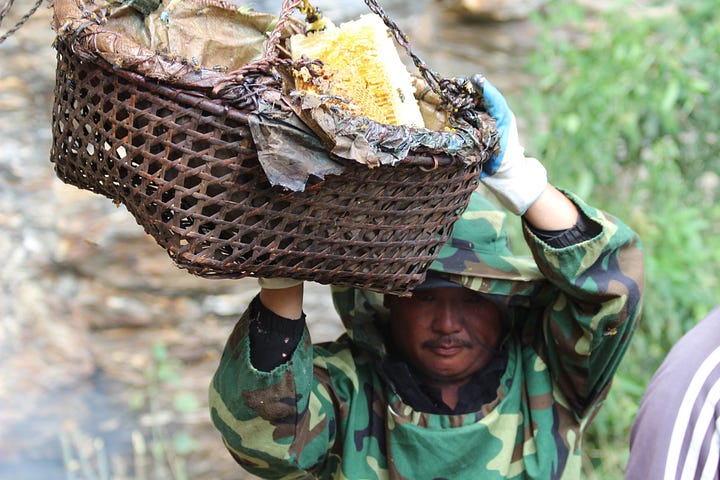

I was initially apprehensive, as the honey didn’t look like any grocery store honey I had encountered. It was slightly cloudy, with small bits of wax and debris. I expressed this concern to a friend, noting that we were probably consuming bits of bees and larvae. He eased my worries with perhaps the most poetic response: that we were tasting the whole process—the bees that labored, the jungle pollen, the smoke from the harvest fire, the royal jelly, the eggs, and everything in between. As an amateur wine enthusiast, I recognized this as the concept of terroir, and marveled at the idea of tasting the very landscape and the labor that brought this golden dollop to my palm. As I licked the stickiness from my fingers, I felt deeply connected to the earth around me: to the people, the bees, and the soil that brought me here.
The honey was unlike anything I’d tasted before—floral and fruity, with distinct berry notes. It was sweet and magical, just as I’d hoped. In the true spirit of consuming the whole process, I accidentally ate a stinger, which stung the roof of my mouth. I laughed it off, knowing I had the worst bee luck lately, having been stung twice—two days in a row—on my toes just before the trip. My foot had swollen, making the hike painful, and I knew it was only fitting that I’d also sting my mouth. But oh well! The honey was worth it.

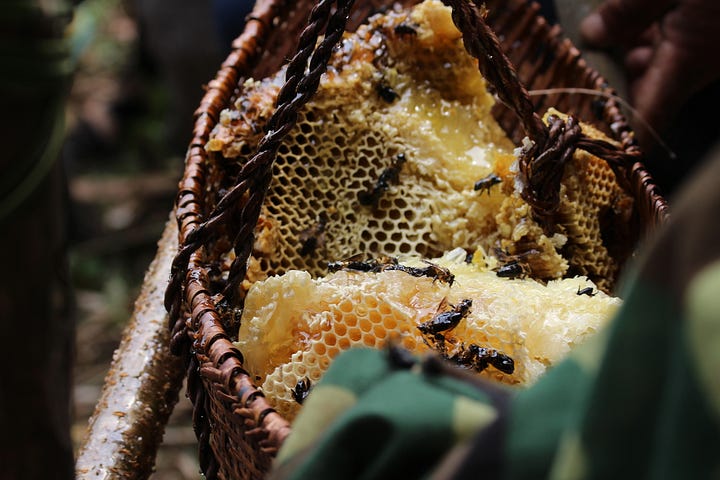
As more honey came down, the festivities picked up. Raksi and chang—local alcoholic beverages—were passed around, along with tarkari, specifically a bean and vegetable curry. Sel roti and bread were also shared to soak up any extra honey. Though the honey hunter was still perched high above, the crowd below grew festive, celebrating the successful hunt and delicious honey. Gradually, people began to leave, full of sweetness and ready for the trek uphill. Before I knew it, only six of us Peace Corps folks remained, along with the honey crew. The mood mellowed, and with fewer tourists, the crew sat down to enjoy the fruits of their labor.
The jungle had never felt more alive or more beautiful. Everyone relaxed, laughed, and enjoyed good company and food. The honey hunter had descended, and we talked to him about his family and honey hunting experiences. I even found out one crew member could speak Japanese. His Japanese was better than his English and better than my Nepali, so we had a great conversation about his time working in Kathmandu for a Japanese company, exchanging silly Japanese phrases that reminded me of my grandfather. He made sure I had enough bread and honey (Townsend joked it was a real "honey bun") and urged me to be careful on the hike back.
I love moments like these. I’m constantly reminded of the kindness and friendliness of Nepali people, and the beautiful way language connects us.
It wasn’t until much later that the last of us decided to leave. We had eaten more than our fair share, knowing we could always buy more the next day (around $25 for a liter—a steal!). This was a magical experience that brought me closer to the people and land around me. I will definitely be coming back for more, maybe even helping plan the next hunt. And if you—yes, you, the lovely readers—ever decide to venture to Nepal, this is one experience you absolutely cannot miss!
Bee well and stay sweet,
Mei 🐝
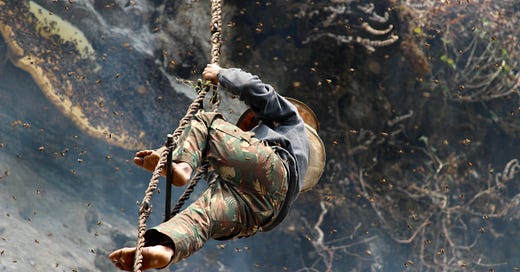


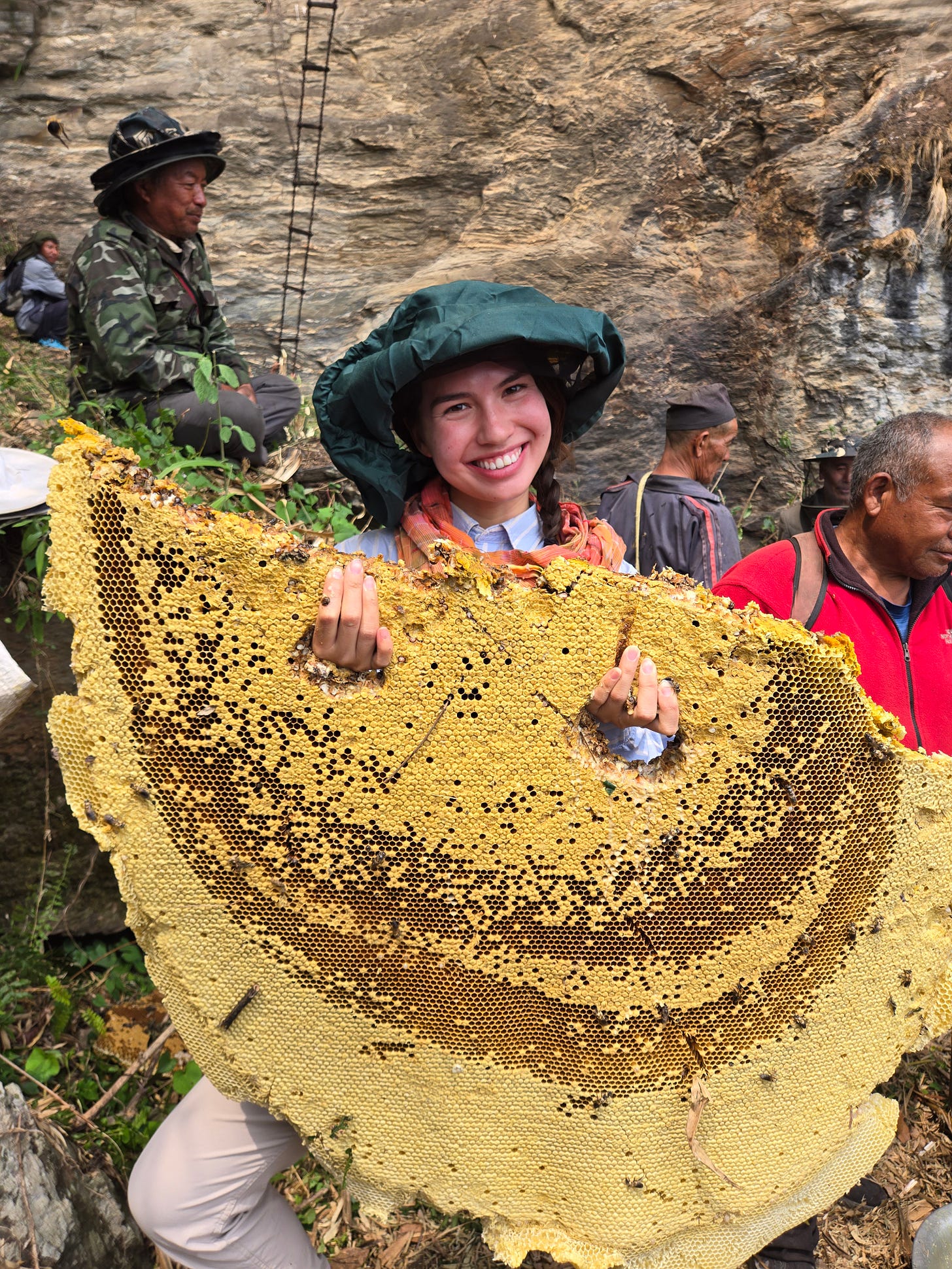


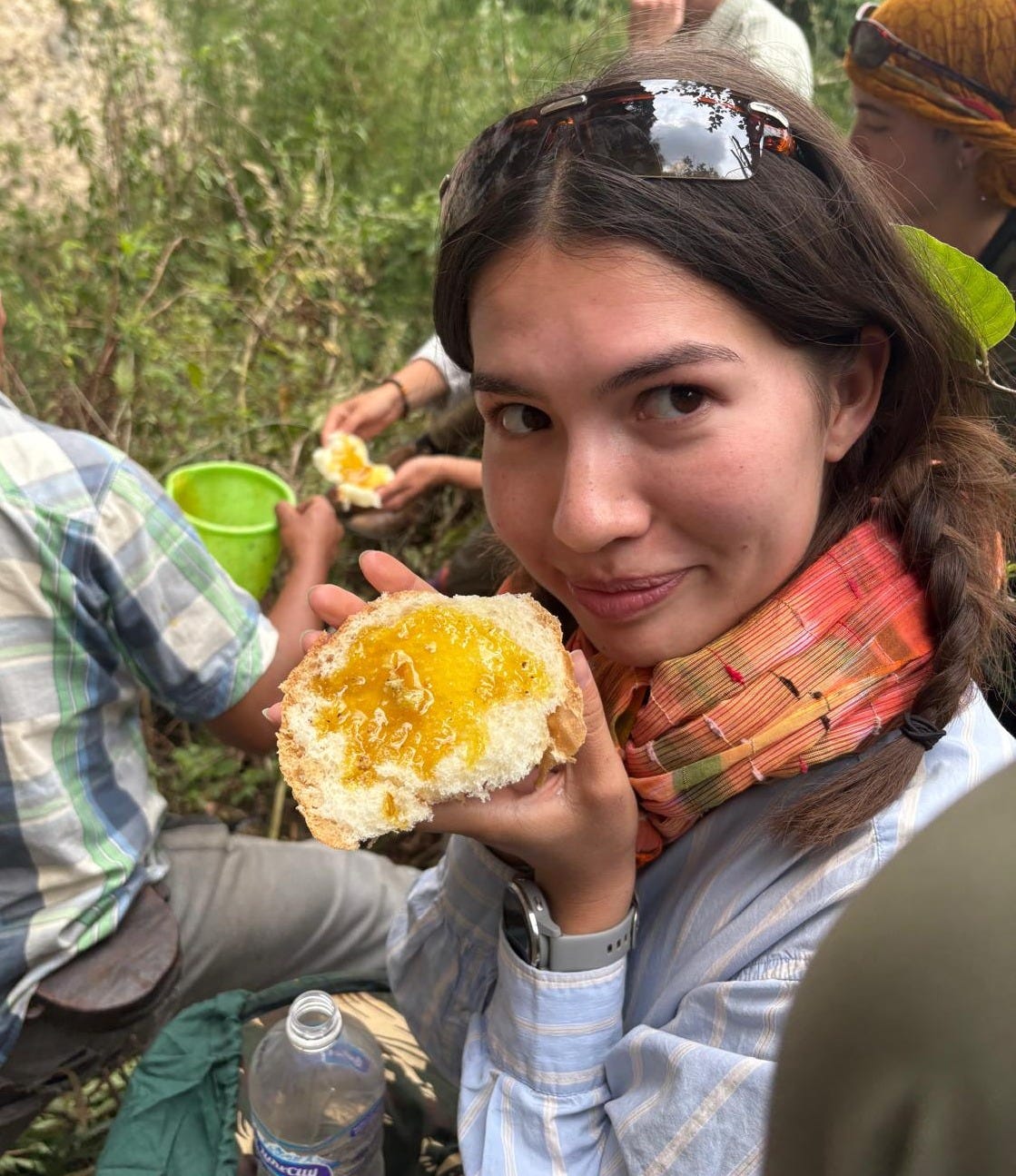
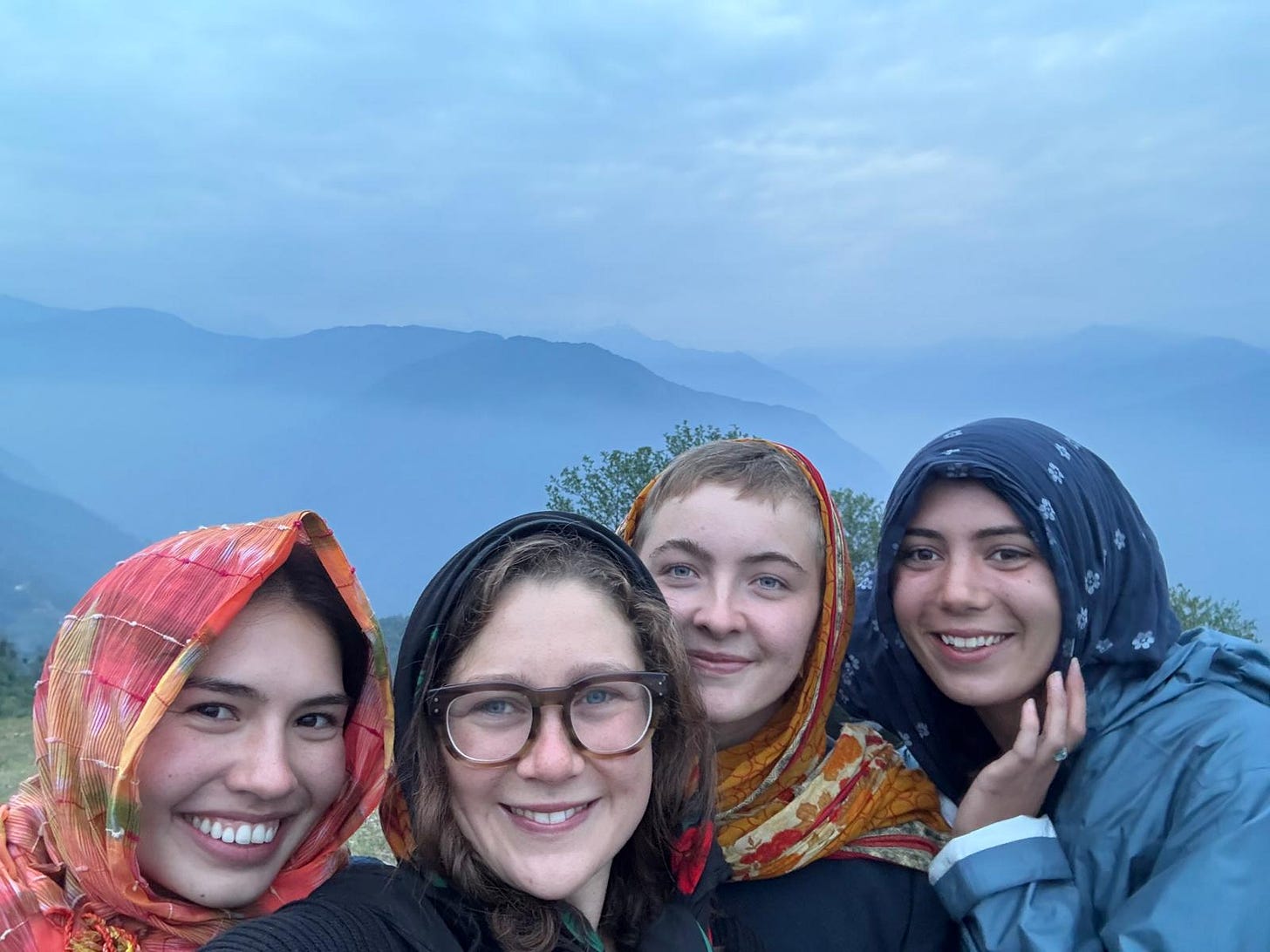
Bee well 🐝😘
Hi Mei 🙂
Kate here
Will’s Mom 🙋🏻♀️
I think my “liking” Will’s post put your posts on my algorithm. Fantastic honey harvesting story ✨The photo of the harvester suspended above is surreal. At first glance it looked like an astronaut in outer space. I’ll look forward to reading more of your posts. Be well ✨stay safe 🙏🏼